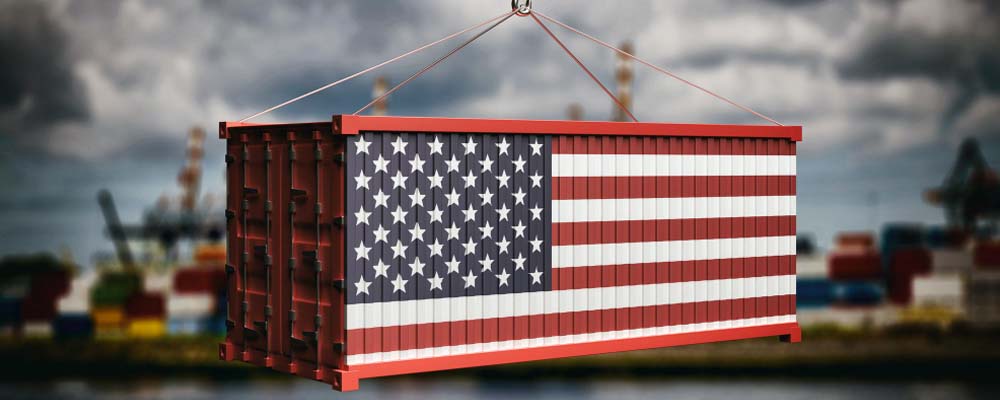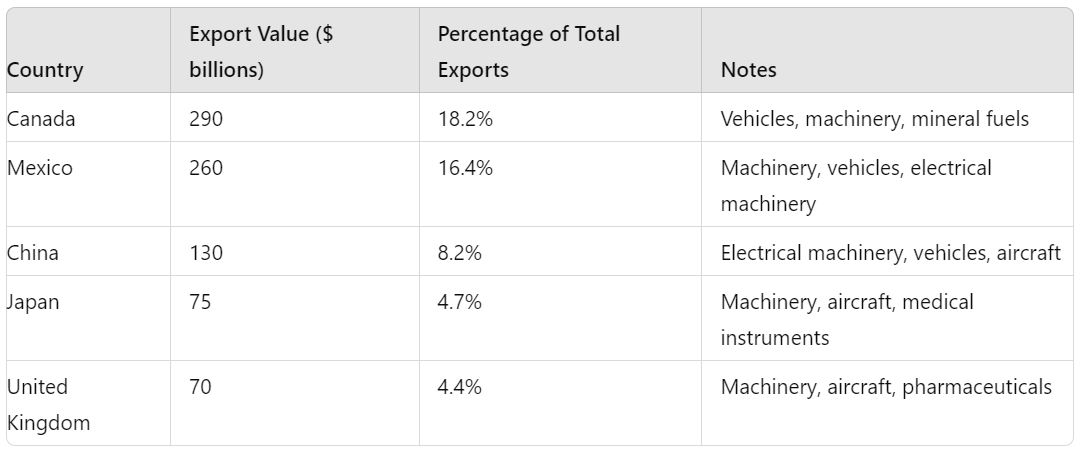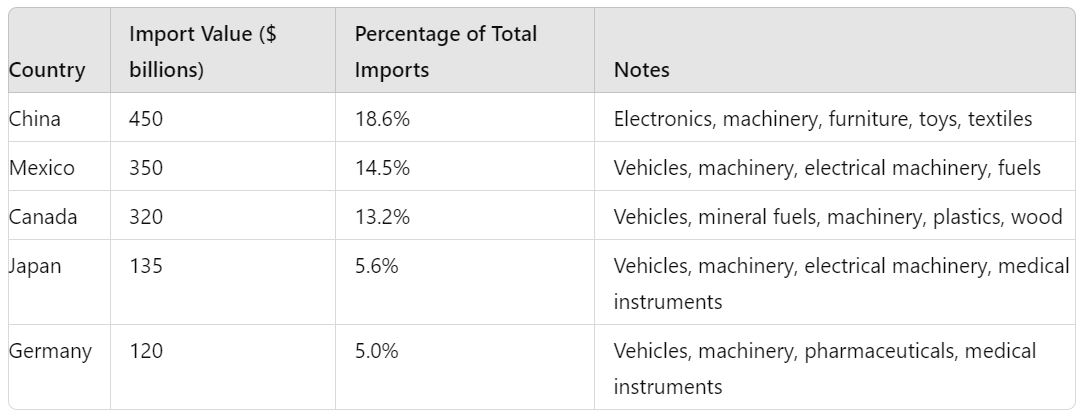
In an increasingly interconnected world, understanding the intricate web of trade relationships is vital for anyone involved in freight forwarding, logistics, importing, exporting, customs brokerage, manufacturing, e-commerce, or related industries. For the United States, the ability to efficiently manage imports and exports significantly affects the economy. This blog will explore the USA’s top trading partners, shining a light on the countries that play a crucial role in America’s international trade landscape.
 USA Top Export Partners
USA Top Export Partners
- Canada
- Value: $290 billion
- Percentage of Total Exports: 18.2%
- Description: Canada stands as the USA’s top export partner, with major exports comprising vehicles, machinery, electrical machinery, mineral fuels, and plastics.
- Mexico
- Value: $260 billion
- Percentage of Total Exports: 16.4%
- Description: Mexico closely follows Canada, importing significant volumes of machinery, vehicles, electrical machinery, mineral fuels, and plastics from the USA.
- China
- Value: $130 billion
- Percentage of Total Exports: 8.2%
- Description: Despite geopolitical tensions, China remains a critical export market for the USA, with substantial exports in electrical machinery, machinery, vehicles, mineral fuels, and aircraft.
- Japan
- Value: $75 billion
- Percentage of Total Exports: 4.7%
- Description: Japan is a key Asian partner, importing primarily machinery, aircraft, vehicles, optical and medical instruments, and electrical machinery from the USA.
- United Kingdom
- Value: $70 billion
- Percentage of Total Exports: 4.4%
- Description: The UK is a major European export destination, with primary American exports including machinery, aircraft, pharmaceuticals, vehicles, and optical and medical instruments.
 USA Top Import Partners
USA Top Import Partners
- China
- Value: $450 billion
- Percentage of Total Imports: 18.6%
- Description: China is the largest source of US imports, providing a wide range of goods including electronics, machinery, furniture, toys, and textiles.
- Mexico
- Value: $350 billion
- Percentage of Total Imports: 14.5%
- Description: Mexico exports significant quantities of vehicles, machinery, electrical machinery, mineral fuels, and medical instruments to the USA.
- Canada
- Value: $320 billion
- Percentage of Total Imports: 13.2%
- Description: Canada‘s key exports to the USA include vehicles, mineral fuels, machinery, plastics, and wood products.
- Japan
- Value: $135 billion
- Percentage of Total Imports: 5.6%
- Description: Japan exports a variety of goods to the USA, with major categories including vehicles, machinery, electrical machinery, and optical and medical instruments.
- Germany
- Value: $120 billion
- Percentage of Total Imports: 5.0%
- Description: Germany provides the USA with a significant amount of vehicles, machinery, pharmaceuticals, optical and medical instruments, and electrical machinery.
 Trade Deficits and Surpluses
Trade Deficits and Surpluses
The United States’ trade balance reflects its economic strengths and challenges. In 2023, the USA recorded an overall trade deficit of $950 billion, driven by deficits with China ($310 billion), Mexico ($100 billion), and Germany ($70 billion) due to high imports of electronics, machinery, vehicles, and pharmaceuticals. However, the USA achieved trade surpluses with Hong Kong ($30 billion), Netherlands ($25 billion), and Brazil ($20 billion), primarily from exports of machinery, aircraft, and agricultural products. This highlights the USA’s pivotal role in global trade as both a major importer of consumer goods and a key exporter of advanced technology.
Continental Trade Distribution
A significant portion of the United States’ trade is concentrated within North America, with approximately 33.6% of exports and 28.9% of imports involving neighboring countries, Canada and Mexico. This is followed by substantial trade volumes with Asia, accounting for 27.4% of exports and 35.7% of imports, primarily driven by trade with China, Japan, and South Korea. Europe also plays a crucial role in the USA’s trade, comprising 20.1% of exports and 23.2% of imports, with significant trade relationships with countries such as Germany, the United Kingdom, and the Netherlands. This distribution highlights the USA’s strategic economic ties across multiple continents, underscoring its pivotal role in the global trade network.
Emerging Markets and New Partnerships
Emerging markets offer new opportunities for American businesses. Countries like India, Brazil, and Vietnam are becoming increasingly significant trade partners. These markets offer a growing consumer base and new avenues for business expansion. American companies are exploring these emerging markets to diversify their export destinations and reduce dependence on traditional markets. These new partnerships also provide opportunities for innovation and collaboration in various sectors.
Sustainable Trade Practices
Sustainable trade practices are becoming a priority for businesses and governments alike. The focus is on reducing carbon footprints, ensuring fair labor practices, and promoting environmentally friendly products. Companies are adopting green technologies and sustainable sourcing practices to meet consumer demand for eco-friendly products. Government initiatives and international agreements also support the shift towards sustainable trade.
Technological Innovations
Technological innovations are transforming the trade landscape. AI, blockchain, and IoT are enhancing supply chain efficiency, transparency, and security. For example, blockchain technology is being used to track and verify the authenticity of products. AI and machine learning algorithms are optimizing supply chain operations and predicting market trends.
Government Initiatives
Government initiatives play a crucial role in facilitating trade. Policies that promote free trade agreements, reduce tariffs, and enhance trade infrastructure support the growth of international trade. The US government is actively working on policies to promote exports and support American businesses in the global market. Initiatives like the Export-Import Bank and trade missions help businesses expand their reach internationally.
 Conclusion
Conclusion
The USA’s trade relationships are a testament to its dynamic and influential role in the global economy. Understanding these intricate partnerships, from top export and import partners to emerging markets, is crucial for businesses involved in international trade.
By leveraging these insights, businesses can identify new opportunities, optimize their supply chains, and stay competitive in an ever-evolving trade landscape. Whether you’re a freight forwarder, logistics provider, importer, exporter, or manufacturer, staying informed about global trade dynamics is key to your success.
Continue exploring these topics and consider how your business can adapt and thrive in this interconnected world. If you’re looking to deepen your understanding of trade practices or need assistance with your logistics, reach out to us for personalized guidance.




 USA Top Export Partners
USA Top Export Partners USA Top Import Partners
USA Top Import Partners Trade Deficits and Surpluses
Trade Deficits and Surpluses Conclusion
Conclusion



